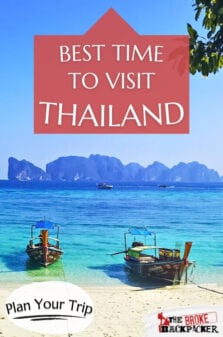Are you planning a trip to Thailand? Wondering when is the best time to visit? Well, you’re in luck! In this ultimate guide, we’ll walk you through the best times to visit Thailand based on weather and events, so you can make the most of your trip. Whether you’re a beach lover, an adventure seeker, or a culture enthusiast, this guide has got you covered!
Thailand experiences a tropical climate with distinct seasons. The weather can vary greatly depending on the region you plan to visit. From November to February, the weather is pleasantly cool and dry, making it the peak tourist season. This is the perfect time to explore the stunning islands of Phuket and Krabi, lounge on the picturesque beaches of Koh Samui, or dive into the vibrant nightlife of Bangkok.
If you’re a nature lover and want to witness the beauty of Thailand’s waterfalls in full flow, then consider visiting during the rainy season from May to October. Yes, it does rain a lot during this time, but it usually doesn’t last all day. Plus, the lush green landscapes and fewer tourists make it a peaceful and budget-friendly time to visit. Just make sure to pack your raincoat and umbrella!
Thailand is known for its vibrant festivals and cultural events that will leave you in awe. Plan your trip around these events to immerse yourself in the local culture. The most famous one is the Songkran Festival, which takes place in mid-April and celebrates the Thai New Year with water fights and street parties. Other must-see events include the Loy Krathong Festival in November, where floating lanterns light up the night sky, and the Yi Peng Festival in Chiang Mai, where thousands of lanterns are released into the sky for good luck.
So, whether you’re a sun seeker, a rain lover, or a festival goer, Thailand has something to offer all year round. In this guide, we’ll delve deeper into each season and highlight the best activities and destinations to make your trip to Thailand unforgettable. Keep reading to find out the best times to visit Thailand based on the weather and events!
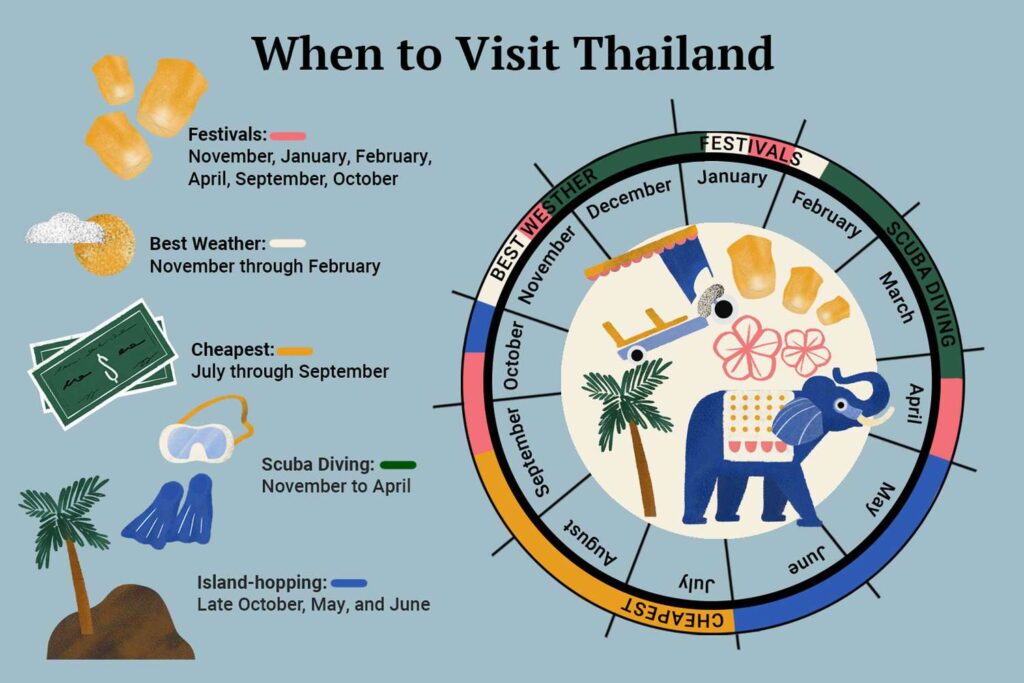
Weather
Thailand, known for its tropical climate and stunning landscapes, offers a range of weather conditions throughout the year. From humid summers to cool winters, each season brings its own charm to this Southeast Asian playground. Whether you’re seeking a beach getaway, a cultural adventure, or an exploration of nature, understanding Thailand’s climate and the best times to visit will ensure you make the most of your trip.
Thailand’s Climate
Thailand boasts a tropical climate characterized by high temperatures and humidity levels year-round. The country experiences three distinct seasons: hot, cool, and rainy. The hot season, which lasts from March to May, is when temperatures can reach their peak, often exceeding 35 degrees Celsius (95 degrees Fahrenheit). Humidity can be stifling during this time, making it less than ideal for outdoor activities.
The cool season, which spans from November to February, is considered the best time to visit Thailand. Temperatures during this period range from 20 to 30 degrees Celsius (68 to 86 degrees Fahrenheit), providing a pleasant and comfortable environment for travel. Visitors can enjoy outdoor activities and explore the country’s attractions without the discomfort of excessive heat.
Finally, the rainy season, which extends from June to October, brings monsoon rains to different regions of Thailand. While some travelers avoid this time of year due to the increased rainfall, it can also offer unique experiences such as lush green landscapes, fewer crowds, and discounted rates on accommodations.
Different Seasons in Thailand
Thailand’s different seasons offer a variety of experiences depending on your interests and preferences. Here’s a breakdown of what you can expect during each season:
-
Hot Season (March to May): This season is characterized by scorching temperatures and high humidity levels. If you can handle the heat, you’ll find fewer tourists and discounted prices on flights and hotels. Remember to stay hydrated and take breaks in air-conditioned spaces.
-
Cool Season (November to February): With milder temperatures and lower humidity, the cool season is undoubtedly the most popular time to visit Thailand. It’s the perfect time to explore the country’s bustling cities, cultural sites, and national parks. Don’t forget to pack a light jacket for cooler evenings.
-
Rainy Season (June to October): While the rainy season may not be everyone’s first choice, it has its own unique appeal. The rainfall can vary across regions, with some areas experiencing short, intense showers and others seeing more constant rainfall. However, the natural beauty of Thailand is amplified during this time, with vibrant flora and flowing waterfalls. Just be prepared with rain gear and flexible travel plans.
Best Time to Visit for Cool Weather
If you’re looking for cooler weather and a respite from the scorching heat, plan your trip during Thailand’s cool season, from November to February. During this time, temperatures are milder, making it comfortable to explore the country’s diverse landscapes. Whether you’re exploring the bustling streets of Bangkok, immersing yourself in the cultural heritage of Chiang Mai, or relaxing on the beaches of Phuket, the cool season provides the ideal conditions for your adventures.
Best Time to Visit for Beach Activities
Thailand’s stunning beaches and crystal-clear waters are a major draw for travelers. Whether you’re an avid swimmer, a sun worshipper, or an underwater explorer, timing your visit to coincide with the best beach conditions is essential.
For the Andaman Coast, which includes popular destinations like Phuket and Krabi, the best time to visit for beach activities is during the dry season from November to April. This period offers clear skies, calm waters, and optimal conditions for snorkeling, diving, and other water sports. However, keep in mind that these beaches can get crowded, especially during peak tourist season. If you prefer a quieter beach experience, consider traveling in the shoulder months of November and April.
On the Gulf of Thailand side, where you’ll find popular destinations like Koh Samui and Koh Tao, the dry season spans from December to August. The months of January to March are particularly favorable for beach activities, with calm seas and pleasant temperatures. During these months, you can soak up the sun, swim in the warm waters, and indulge in the relaxed beach lifestyle that Thailand is famous for.
Events
Thailand’s vibrant culture is reflected in its countless festivals and events throughout the year. These celebrations offer a unique insight into Thai traditions, customs, and spirituality. Attending these festivals can be an unforgettable experience, giving you a deeper understanding of the country’s rich heritage.
Popular Festivals in Thailand
Thailand is renowned for its colorful and lively festivals, attracting visitors from all over the world. Here are a few of the most popular festivals that you should consider experiencing during your trip:
-
Thai New Year (Songkran): Celebrated in mid-April, Songkran marks the traditional Thai New Year. It is known for its water fights, where locals and tourists alike engage in friendly water battles on the streets. This festival symbolizes a fresh start and is a fun way to cool off from the scorching heat.
-
Loi Krathong Festival: Taking place on the full moon night of the 12th lunar month (usually in November), the Loi Krathong Festival is a magical celebration of lights and water. Participants release floating lanterns (krathongs) into rivers or lakes, symbolizing the release of negativity and the welcoming of good fortune.
-
Monkey Buffet Festival: Held annually in Lopburi, the Monkey Buffet Festival pays homage to the monkeys that inhabit the town. Locals prepare a feast for them, with over 2,000 kilograms (4,400 pounds) of food, including fruits, vegetables, and desserts. This quirky and unique festival attracts animal lovers and curious travelers alike.
Thai New Year (Songkran)
One of the most exciting and beloved festivals in Thailand is Songkran, the traditional Thai New Year. Lasting for three days in mid-April, this festival marks the transition from the dry season to the rainy season, bringing relief from the scorching heat.
The highlight of Songkran is the water fights that take place throughout the country. It’s a time when Thais and tourists come together to douse each other with water, using water guns, buckets, and even elephants carrying giant water cannons. The streets turn into a battlefield, with laughter, joy, and camaraderie filling the air.
Songkran is not only about water fights, but it also holds strong cultural and spiritual significance for the Thai people. It’s a time for cleaning and purifying both the home and the self, with families visiting temples to make merit, offering food to monks, and bathing the Buddha images. The festival also involves traditional rituals such as the pouring of scented water over the hands of elders to seek their blessings.
Loi Krathong Festival
Imagine a night filled with soft candlelight, the sound of gently flowing water, and the beauty of thousands of floating lanterns illuminating the night sky. This enchanting scene is what awaits you at the Loi Krathong Festival.
Celebrated on the night of the full moon in the 12th lunar month (usually in November), Loi Krathong is a nationwide event that pays homage to the goddess of water. The festival involves releasing small, decorative vessels made of banana leaves (krathongs) into rivers, canals, and lakes. These krathongs are adorned with flowers, incense sticks, and a candle, symbolizing the release of negative energy and the welcoming of good fortune.
The sight of the floating krathongs, along with the mesmerizing display of lit lanterns drifting into the night sky, creates an atmosphere of tranquility and spiritual reverence. The festival is also known for its fireworks displays, traditional dance performances, and beauty pageants, adding to the festive ambiance.
Monkey Buffet Festival
For a truly unique and offbeat experience in Thailand, make sure to schedule your visit during the Monkey Buffet Festival. Held annually in Lopburi, a town known for its monkey population, this festival combines Thailand’s love for monkeys with a grand feast fit for these mischievous creatures.
During the festival, locals create an extravagant buffet, consisting of over 4,400 pounds of food, ranging from fruits and vegetables to desserts. The feast is then laid out on tables and offered to the monkeys that roam freely in the town. The sight of hundreds of monkeys indulging in the buffet is a spectacle like no other, creating an atmosphere of wonder and amusement.
The Monkey Buffet Festival not only celebrates the monkey population but also serves as a way to promote tourism in Lopburi. Visitors can witness the unique bond between the people and the monkeys, while also enjoying cultural performances, live music, and traditional Thai food.
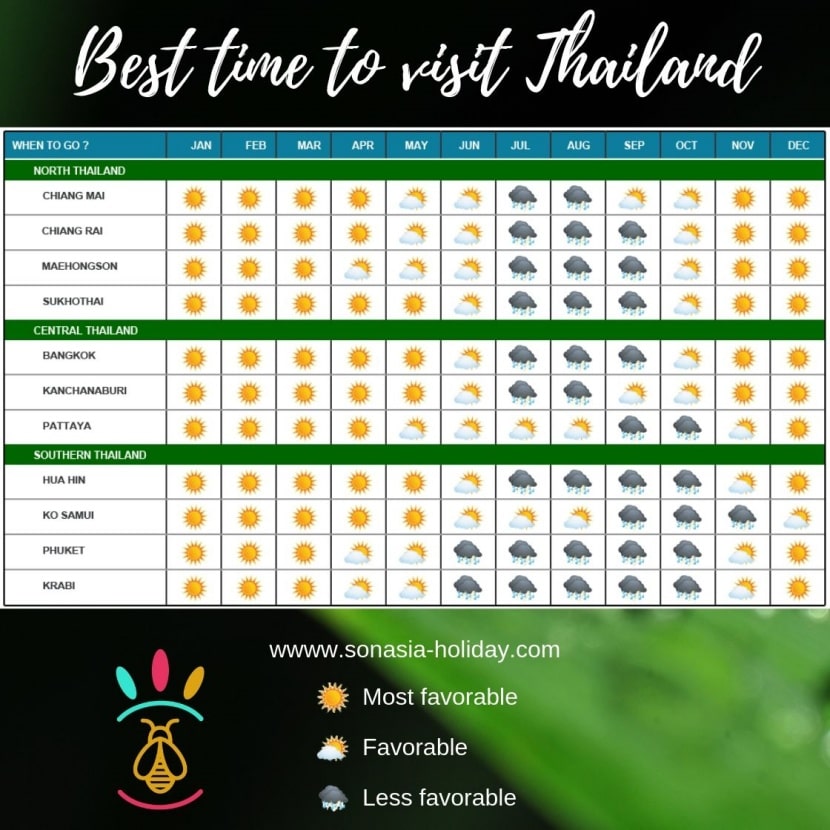
Northern Thailand
###[Chiang Mai region]
Located in the mountainous region of Northern Thailand, Chiang Mai offers a captivating blend of ancient temples, lush landscapes, and vibrant street markets. This cultural hub provides a perfect gateway to explore the country’s rich heritage and immerse yourself in local life.
Best Time to Visit Chiang Mai
The best time to visit Chiang Mai is during the cool season, from November to February. With milder temperatures and clear skies, this period offers comfortable weather for exploring the city and its surroundings. The cool season also coincides with the famous Yi Peng Festival, where thousands of lanterns are released into the night sky, creating an ethereal spectacle.
Highlights of Northern Thailand
-
Doi Suthep: Perched on a mountain offering panoramic views of Chiang Mai, Doi Suthep is a must-visit temple. The intricate golden spire and the serene atmosphere make it a sacred and awe-inspiring place.
-
Elephant Nature Park: If you’re passionate about ethical tourism and animal welfare, a visit to the Elephant Nature Park is a must. Here, you can observe and interact with rescued elephants in a natural and humane environment.
-
Chiang Rai: A day trip from Chiang Mai, Chiang Rai is famous for the White Temple (Wat Rong Khun). This unique architectural masterpiece is adorned with intricate carvings and mirrors, creating a dazzling effect.
-
Thai Cuisine: Northern Thailand is renowned for its flavorful and aromatic cuisine. Don’t miss the opportunity to try regional specialties like khao soi (curried noodle soup), sai ua (spicy sausage), and sticky rice with mango.
Southern Thailand
###[Phuket and Krabi]
Located on the Andaman Sea, Phuket and Krabi are two of the most popular beach destinations in Thailand. With their pristine white sand beaches, crystal-clear waters, and stunning limestone cliffs, they offer a tropical paradise for sun-seeking travelers.
Best Time to Visit Phuket and Krabi
The best time to visit Phuket and Krabi for beach activities is during the dry season, which stretches from November to April. During this time, you can enjoy clear skies, calm waters, and ideal conditions for swimming, snorkeling, and diving.
Exploring the Islands
Phuket and Krabi are excellent bases for exploring the nearby islands, each offering its own unique charm and attractions. Here are some of the must-visit islands in this region:
-
Phi Phi Islands: Known for their breathtaking beauty, the Phi Phi Islands are a paradise for beach lovers and nature enthusiasts. Maya Bay, made famous by the movie “The Beach,” is a highlight, along with the vibrant marine life for snorkeling and diving.
-
James Bond Island: Made famous by the James Bond film “The Man with the Golden Gun,” this iconic island in Phang Nga Bay is characterized by its towering limestone karsts. A boat tour around the bay will allow you to admire these stunning geological formations.
-
Koh Lanta: With its laid-back vibe and pristine beaches, Koh Lanta is a perfect escape for those seeking tranquility and natural beauty. The island offers a range of accommodations, from luxurious resorts to budget-friendly bungalows.
-
Railay Beach: Accessible only by boat, Railay Beach is a hidden gem known for its dramatic limestone cliffs and crystal-clear waters. It’s a paradise for rock climbing enthusiasts, with many challenging routes available.
Snorkeling and Diving Opportunities
Southern Thailand, with its extensive coastline and abundant marine life, offers exceptional opportunities for snorkeling and diving. The underwater world in this region is teeming with vibrant coral reefs, tropical fish, and even the occasional encounter with majestic marine creatures such as sea turtles and reef sharks.
Some of the best snorkeling and diving spots in Southern Thailand include:
-
Similan Islands: Located off the coast of Phang Nga Province, the Similan Islands are a renowned diving destination. The clear waters, diverse marine life, and stunning coral reefs make it a paradise for both beginners and experienced divers.
-
Koh Rok: Situated in the Mu Koh Lanta National Park, Koh Rok is known for its crystal-clear turquoise waters, colorful corals, and abundance of marine life. Snorkelers can explore the vibrant reefs just a few meters from the shore.
-
Surin Islands: Another pristine archipelago in the Andaman Sea, the Surin Islands offer untouched beauty and exceptional snorkeling opportunities. The islands are home to a variety of coral species and an abundance of marine creatures, including the rare and elusive dugong.
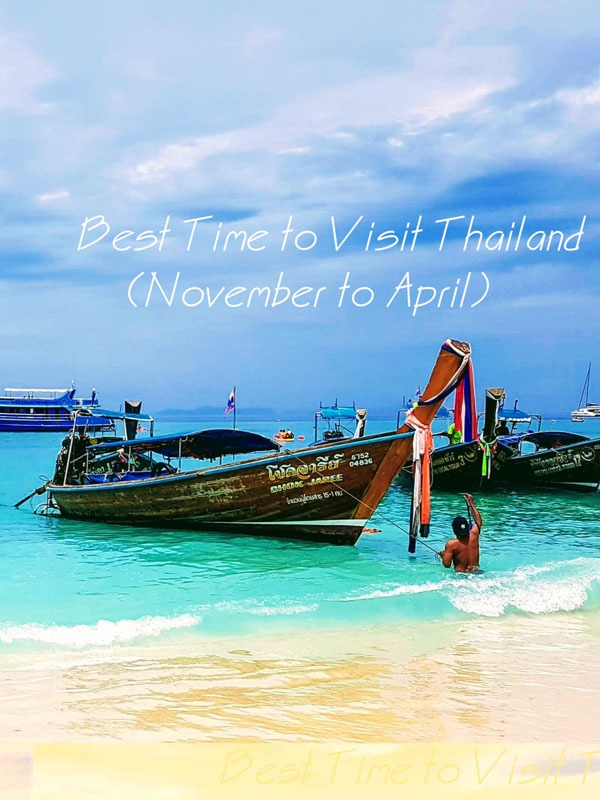
Bangkok
Exploring the Capital City
As Thailand’s bustling capital city, Bangkok offers a mix of traditional heritage and modern attractions. From ornate temples and impressive palaces to vibrant markets and a buzzing nightlife scene, this city has something to offer for every type of traveler.
Best Time to Visit Bangkok
The best time to visit Bangkok is during the cool season, from November to February. With milder temperatures, lower humidity, and clear skies, the weather is perfect for exploring the city’s cultural sites and outdoor attractions. It’s also a pleasant time to cruise along the Chao Phraya River and savor the flavors of Thai street food.
Temples and Cultural Sites
Bangkok is home to numerous temples and cultural landmarks that reflect the country’s rich history and deep spirituality. Here are some must-visit sites in the city:
-
Wat Arun: Known as the Temple of Dawn, Wat Arun is one of Bangkok’s most iconic landmarks. Its towering spires and intricate design make it a sight to behold, especially when illuminated at night.
-
Grand Palace and Wat Phra Kaew: The Grand Palace complex is a mesmerizing architectural wonder, with its ornate buildings and meticulously manicured gardens. Within the palace grounds, you’ll find Wat Phra Kaew, the Temple of the Emerald Buddha, which houses Thailand’s most sacred Buddha image.
-
Wat Pho: Home to the famous Reclining Buddha, Wat Pho is one of the oldest and largest temples in Bangkok. The 46-meter-long golden statue is a sight not to be missed, and the temple complex itself is a tranquil oasis in the bustling city.
-
Jim Thompson House: The former home of American silk merchant Jim Thompson has been converted into a museum showcasing Thai art and architecture. Explore the traditional teakwood house and learn about Thompson’s contributions to the revival of the Thai silk industry.
Nightlife and Shopping
Bangkok’s vibrant nightlife and bustling markets are a testament to its reputation as a city that never sleeps. From rooftop bars offering panoramic views to night markets brimming with local delicacies and trendy shopping malls, there’s something to suit every taste:
-
Khao San Road: A backpacker’s haven, Khao San Road is famous for its lively atmosphere, street food stalls, and budget-friendly accommodations. Enjoy the energetic nightlife, soak in the vibrant street scene, and pick up souvenirs at the bustling market stalls.
-
Asiatique The Riverfront: Located on the banks of the Chao Phraya River, Asiatique offers a unique shopping and entertainment experience. With a mix of boutique shops, restaurants, and a Ferris wheel, it’s a great place to spend a relaxing evening.
-
Rooftop Bars: Bangkok is renowned for its rooftop bars, providing breathtaking views of the city skyline. Sip on a cocktail while enjoying panoramic vistas at popular spots like Sky Bar at Lebua State Tower and Octave Rooftop Lounge & Bar.
-
Chatuchak Weekend Market: One of the largest markets in the world, Chatuchak Weekend Market is a shopaholic’s paradise. With over 15,000 stalls selling everything from clothing and accessories to handicrafts and home decor, it’s a treasure trove for unique finds.
Isaan Region
Experiencing the Northeastern Part of Thailand
If you’re looking to venture off the beaten path and experience the authentic side of Thailand, head to the Isaan Region in the northeastern part of the country. This less-explored region offers a unique cultural heritage, distinct traditions, and delicious cuisine.
Unique Cultural Heritage
Isaan is known for its strong Lao and Khmer influences, which are reflected in its architecture, language, and traditions. While the region may not boast the same level of tourism infrastructure as other parts of Thailand, it offers a glimpse into the country’s rural way of life and a chance to interact with locals on a deeper level.
Best Time to Visit Isaan Region
The best time to visit the Isaan Region is during the dry season, which runs from November to April. This period offers pleasant weather for exploring the region’s historical sites, national parks, and local markets. The cooler temperatures ensure a comfortable experience, especially when visiting attractions such as the UNESCO World Heritage-listed Khmer temple complex of Phimai Historical Park.
Local Cuisine and Traditions
Isaan is not only known for its unique cultural heritage but also for its distinctive cuisine. Spicy and bold in flavor, Isaan food features staples such as sticky rice, grilled meats, fermented fish, and a variety of herbs and spices. Don’t miss the opportunity to savor dishes like som tam (green papaya salad), larb (spicy minced meat salad), and pla ra (fermented fish).
In addition to its culinary delights, the region also celebrates a number of vibrant festivals such as Bun Bang Fai (Rocket Festival) and Phi Ta Khon (Ghost Festival). These lively events offer a chance to witness traditional dances, music performances, and processions, accompanied by colorful costumes and elaborate masks.
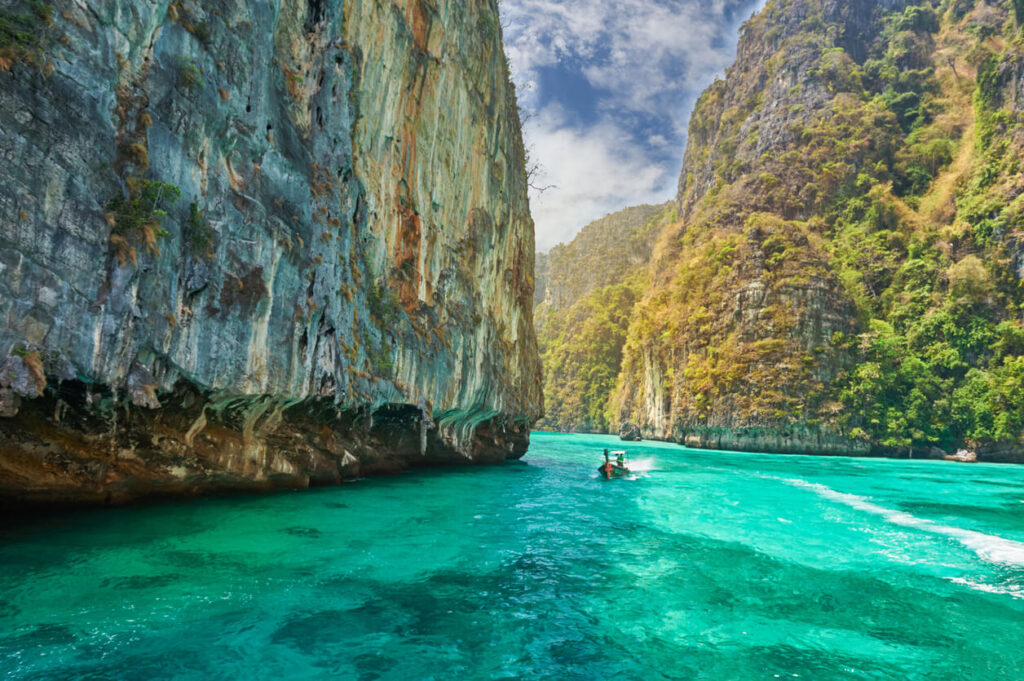
Andaman Coast
Phang Nga Bay
Located between the island of Phuket and the mainland, Phang Nga Bay is famous for its dramatic limestone karsts jutting out of emerald-green waters. This stunning natural phenomenon, featured in movies like “The Man with the Golden Gun” and “Avatar,” attracts visitors from around the globe.
Exploring the bay by boat is the best way to fully appreciate its beauty. Take a leisurely cruise, kayak through hidden lagoons, and swim in secluded coves. Visit iconic spots like James Bond Island (Khao Phing Kan) and the floating village of Koh Panyee, where you can immerse yourself in the local way of life.
Similan Islands
For diving enthusiasts, the Similan Islands are a must-visit destination. Located in the Andaman Sea, this archipelago is renowned for its crystal-clear waters, vibrant coral reefs, and abundant marine life. Snorkelers and divers can explore the underwater wonderland, encountering colorful fish, sea turtles, and even reef sharks.
The Similan Islands are a protected marine national park, ensuring that the underwater ecosystem remains pristine and untouched. The best time to visit for diving is during the dry season, from mid-October to mid-May, when visibility is at its best.
Best Time to Visit the Andaman Coast
The best time to visit the Andaman Coast is during the dry season, from November to April. During this period, the weather is generally sunny with calm waters, making it ideal for island hopping, water sports, and exploring the region’s natural wonders. However, keep in mind that this is also the peak tourist season, so popular destinations may be crowded.
Water Sports and Activities
The Andaman Coast offers a wide range of water sports and activities for thrill-seekers and nature lovers alike. Whether you’re seeking adrenaline-pumping adventures or serene moments of relaxation, there’s something for everyone:
-
Scuba Diving and Snorkeling: Explore the vibrant coral reefs and diverse marine life that thrive in the clear waters of the Andaman Sea. Whether you’re a seasoned diver or a beginner snorkeler, there are options for all skill levels.
-
Kayaking and Canoeing: Discover hidden caves, lagoons, and mangrove forests by kayak or canoe. Paddle your way through limestone karsts and immerse yourself in the region’s natural beauty.
-
Boat Tours and Island Hopping: Hop on a boat tour to explore the stunning islands of the Andaman Coast. Visit iconic spots, swim in secluded coves, and enjoy breathtaking views of the turquoise waters.
-
Rock Climbing: Krabi, in particular, is a mecca for rock climbing enthusiasts. With its towering limestone cliffs, it offers a range of routes suitable for climbers of all levels, from beginners to experts.
Gulf of Thailand
Koh Samui
Koh Samui, the second-largest island in Thailand, is a popular destination for beach lovers and luxury seekers. With its palm-fringed beaches, upscale resorts, and vibrant nightlife, it offers a mix of relaxation and entertainment options.
Koh Tao
Known as a diving paradise, Koh Tao is a smaller island in the Gulf of Thailand. With its crystal-clear waters, colorful coral reefs, and abundant marine life, it attracts divers and snorkelers from around the world. The island also offers stunning viewpoints, hiking trails, and a laid-back atmosphere.
Best Time to Visit the Gulf of Thailand
The best time to visit the Gulf of Thailand is during the dry season, which runs from December to August. The months of January to March are particularly favorable for beach activities, with calm seas, sunny weather, and pleasant temperatures. This is the ideal time to enjoy the sandy beaches, swim in the warm waters, and soak up the tropical atmosphere.
Relaxing Beach Destinations
The Gulf of Thailand boasts idyllic beach destinations perfect for a relaxing and rejuvenating getaway. Here are some of the must-visit beaches in this region:
-
Chaweng Beach (Koh Samui): With its powdery white sand and clear turquoise waters, Chaweng Beach is the most popular and developed beach on Koh Samui. It offers a wide range of accommodations, restaurants, and beachfront bars.
-
Lamai Beach (Koh Samui): Located south of Chaweng, Lamai Beach offers a quieter and more laid-back atmosphere. It’s an ideal spot for couples and families looking to enjoy a peaceful beach vacation.
-
Haad Rin Beach (Koh Phangan): Famous for its full moon parties, Haad Rin Beach on Koh Phangan is known for its vibrant nightlife. Outside of the party scene, the beach offers stunning sunsets and a relaxed beach vibe.
-
Sairee Beach (Koh Tao): Sairee Beach is the longest and most popular beach on Koh Tao. It’s the hub for divers and snorkelers, with easy access to nearby dive sites and a range of beachfront accommodations and restaurants.
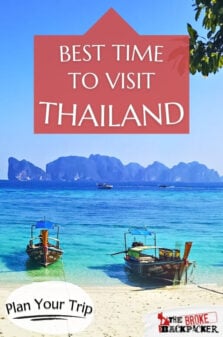
Culture and Etiquette
Respecting Thai Customs
When visiting Thailand, it’s essential to respect the local customs and traditions. Thais place great importance on politeness, respect, and harmony. Here are some cultural tips to keep in mind:
-
Wai Greeting: The traditional Thai greeting, known as the “wai,” involves pressing your palms together in a prayer-like gesture and bowing slightly. It is a sign of respect and should be reciprocated when greeted in this manner.
-
Dress Modestly in Temples: When visiting temples or other religious sites, it’s crucial to dress modestly. This means covering your shoulders, chest, and knees. Remove your shoes before entering temple grounds and avoid pointing your feet at Buddha images.
-
Remove Your Shoes: It’s customary to remove your shoes when entering someone’s home, certain shops and restaurants, and places of worship. Look for cues, such as a row of shoes outside, to determine if you should follow this custom.
-
Avoid Public Displays of Affection: Thais are reserved when it comes to public displays of affection. It’s important to respect local customs and refrain from excessive displays of affection in public spaces.
Etiquette in Temples
When visiting temples in Thailand, it’s essential to observe proper etiquette to show respect for the religious sites and the local culture. Here are some guidelines to follow:
-
Dress Modestly: As mentioned before, dress modestly when entering temples. Avoid wearing revealing or inappropriate clothing, and ensure your shoulders, chest, and knees are covered.
-
Be Quiet and Respectful: Temples are places of quiet reflection and spiritual worship. Keep your voice low and avoid disruptive behavior such as running or shouting.
-
Don’t Touch Monks or Their Robes: It is considered disrespectful to touch monks or their saffron-colored robes, as they are symbols of their religious devotion. Maintain a respectful distance when in the presence of monks.
-
Remove Your Shoes: As with entering someone’s home, it is customary to remove your shoes before entering the temple grounds. Look for signs or observe local customs to determine if this is necessary.
Traditional Thai Greetings
Thais are known for their warm and friendly nature, and understanding traditional greetings can help you connect with locals on a deeper level. Here are some common greetings used in Thailand:
-
Sawasdee (Hello): This is the most common greeting in Thailand and is typically accompanied by the wai gesture, as mentioned earlier.
-
Khob Khun (Thank You): Express your gratitude by saying “khob khun” and following it up with a slight bow or the wai gesture.
-
Sawasdee Pee Mai (Happy New Year): During the Thai New Year (Songkran) in April, people wish each other a “sawasdee pee mai” to celebrate the occasion.
-
La Kon (Goodbye): To bid farewell, you can say “la kon” and bow slightly or say “la gon” to a group of people.
Dos and Don’ts in Thailand
To ensure a positive and respectful experience in Thailand, it’s important to be aware of certain cultural norms and practices. Here are some dos and don’ts to keep in mind:
-
Do Carry Cash: While credit cards are accepted at larger establishments, having cash on hand is useful for small transactions and in more remote areas.
-
Do Use Your Right Hand: In Thai culture, the left hand is considered unclean. It’s polite to use your right hand for gestures such as handing money, receiving objects, or giving and receiving souvenirs.
-
Don’t Point with Your Feet: Thai people consider the feet the lowest and dirtiest part of the body. Avoid pointing your feet at people, especially monks or Buddha images.
-
Don’t Disrespect Buddha Images: Buddha images are sacred to Thai people. Treat them with reverence and avoid climbing, touching, or posing disrespectfully in their presence.
-
Don’t Disrespect the King or Royal Family: The Thai monarchy is highly revered, and it is illegal to criticize or make disrespectful comments about the king or the royal family.
Conclusion
Thailand offers a wealth of experiences, from its vibrant festivals and cultural heritage to its stunning beaches and natural wonders. By considering the weather patterns and local events, you can plan a trip that aligns with your interests and preferences.
Whether you choose to immerse yourself in the cultural wonders of Chiang Mai, unwind on the beaches of Phuket and Krabi, or explore the bustling streets of Bangkok, Thailand is sure to captivate you. Respect the local customs, embrace the warmth of the Thai people, and make the most of your visit to this diverse and enchanting country.
